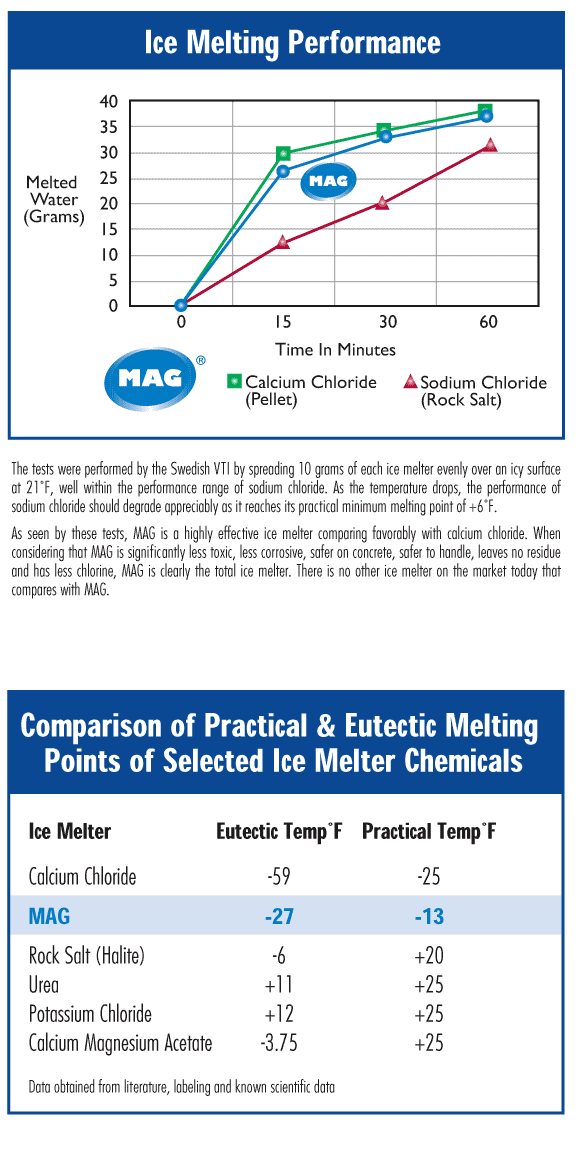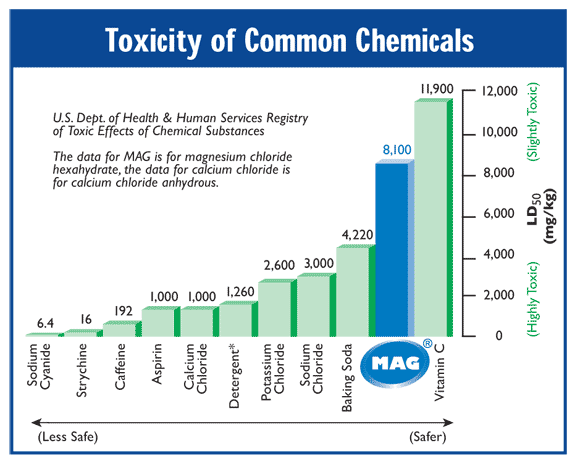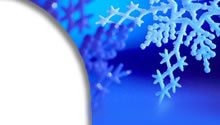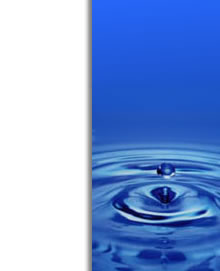|
How to pick the right ice melter for your needs.
Printable PDF version (288Kb)
We get a lot of calls asking about what deicer to use. What are the best products to melt the ice and snow on city streets, parking garages, hospital entry-ways, sidewalks, and driveways? What about the daycare center where children crawl and they pick up deicers on their hands and then potentially taste them? How about the canine kennel where pets are exposed? Frequently that question comes in the broad form; “What’s your best ice-melter?” Our answer is always the same: It depends on your situation.
There are hundreds of brands and types of products that can melt snow and ice, but there is only one thing consumers and users need to know about them: the chemical ingredients. While it appears that these hundreds of products are all different, actually there are very few – a handful at most – that comprise the lion’s share of all deicers on the market today. They are differentiated by their performance, the chemistry, and their respective costs. While the myriad of options can be confusing, understanding the differences in product ingredients and how they work can make choosing the right product much easier.
THE BASICS
The basic factors to consider should really be done from the ground up. What is the surface you are treating made of and where will the runoff go? If you have a wooden deck for example, did you know that using any chloride based product can create two potential hazards? First the chloride component will attack the fastening system used to hold the deck together as it becomes diluted and saturates the deck, and secondly the brine may tend to attract moisture in the capillary pores of the wood allowing it to re-freeze as black ice. Ever notice how frost seems to stay on a wooden deck? So the surfaces you treat are the first thing you must consider when choosing the right deicer.
The next area of consideration is what we call source point collateral impact. How will areas beyond where the deicer is used be affected? Where will the runoff containing deicer go, or where will deicers be carried by vehicular and foot traffic? Are there any downstream environmental issues of which you need to mindful such as waterways, wetlands, or aquifers? For example, we frequently see “no salt zone” signs posted on highways adjacent to reservoirs. This is because surface and shallow well potable (drinking) water supplies are protected from elevated sodium levels from salt run-off to minimize the dangers of elevated sodium levels to users within the distribution system who have hypertension. Because the nature of deicing is inexact, over-application is the standard in most cases and that leads to collateral impact as the “extra” deicer is tracked off-site, runs off-site, or seeps into the environment. How that secondary aspect affects your situation is something that should be strongly considered.
The third and final area of consideration is a little higher up from the snow; it’s your wallet. What is the cost per pound?
BALANCING ACT
We constantly preach to our customers and distributor partners that snow and ice control is a balancing act. You are balancing performance, which is generally defined as a black and wet surface, against adverse consequences, which encompasses everything from cost, to the right chemistry for your environment, collateral impact, and toxicity. A powerful deicer might do a great job of keeping a walkway open but it also might kill all the fish in the goldfish pond, help to destroy the concrete, and be tracked in the building and ruin the rugs.
THE BIG FIVE
As we’ve said, there are basically five common deicers that comprise 95% of the market; sodium chloride, magnesium chloride, calcium chloride, potassium chloride, and acetates. Let’s address them in increasing order of cost with the lowest cost first:
- Sodium Chloride (NaCl): Also called rock salt this is one of the most abundant chemical compounds found on the earth. It is harvested by a variety of methods from mining both by open mines and underground mines; it is evaporated from brines that are flooded into pans from natural sources on the surface such as the sea; and, it is solution mined where we pump it from underground salt domes as a concentrated brine. As a deicer, sodium chloride is number one by a landslide because it is cheap, readily available, and found the whole world over. It will melt snow and ice effectively at temperatures down to +16 degrees, but performs best in the mid-20s. Sodium chloride contains 67% chlorides and about 30% sodium so consider that these two ingredients will end up causing 90% of the benefit and 100% of the problems.
- Magnesium Chloride (MgCl2): A premium or high performance deicer because of its effectiveness, it is a naturally occurring chloride compound like sodium chloride,. Magnesium chloride is found throughout the world in surface and underground mineral reserves. Magnesium chloride is more expensive than sodium chloride but less than calcium and potassium chlorides. In the US, the Great Salt Lake is a major source of magnesium chloride along with similar places in the world like the Dead Sea. It is also solution mined from vast reserves under Northern Europe, China, and in the US as well (pun intended). In the commercial deicer form as a dry hexahydrate, magnesium chloride contains 34% chlorides and 18% Magnesium. It’s gentle on most surfaces and vegetation as well as pet safe and has gained wide popularity in the last few decades because it doesn’t track and its low environmental impact. It’s very low toxicity is comparable to Vitamin C. Found in pellet, flake, and liquid solutions from 25-35%, magnesium chloride has exploded in use and demand in the world over the past two decades because of it balances high performance with low environmental impact. It will melt snow and ice effectively down to -13F.
- Calcium Chloride (CaCl2): Another naturally occurring chloride like sodium and magnesium, calcium chloride is predominately found only in underground brines where it is brought the to the surface, refined and dried. Calcium chloride is more expensive than both sodium and magnesium chlorides. Calcium chloride is far and away the most recognized premium deicer because it has been widely used in the US for over 100 years. Tried and true this powerful premium deicer comes in pellet, flake, and liquid forms. Like salt, calcium can be messy when it is tracked in and its toxicity is the highest of all chloride based deicers. Long established and far and away the lowest temperature deicer, it will melt ice to -25F. It tends to be a little harder on surfaces but it does a great job, Most premium deicers compare their performance to calcium chloride because it is so well recognized.
- Potassium Chloride (KCl): A naturally occurring chloride like the others mentioned above, potassium chloride is actually used very little as a deicer at this time. It is the principle ingredient in fertilizers as a source of potassium. If you buy potassium chloride at a fertilizer dealer or farm supply, you would order it by it’s fertilizer designation of macro-nutrients: 0-0-60 (Nitrogen-Phosphorus-Potassium). It is 60% potassium and only 37% chlorides so while it’s very easy on the environment it is also fairly ineffective as a deicer because it doesn’t melt below +25F. People tend to like it because of the fact that its so environmentally friendly but in recent years the cost of fertilizers coupled with insanely rising prices in fertilizers have driven potassium chloride quickly from the #2 spot to the #4 spot on the ascending cost scale. It has risen in price more than 10 fold from $80 in just the last three years so this year (2008/2009) we are seeing virtually no potassium chloride in deicers other than background levels which occur naturally. At over $1000/ton in bulk currently potassium chloride has exited the market as a deicer in most places and has been replaced by magnesium chloride which is it’s first cousin.
- Acetates: Commonly found in three forms; sodium acetate, calcium magnesium acetate, and potassium acetate, acetate deciers are not chloride based and take an entirely different approach to the task of deicing and the market. They protect surfaces and structures from chloride damage because they don’t contain any chlorides. They are organic chemical compounds that break down naturally in the environment and leave little adverse impact. Those benefits come at a steep price because the main ingredients used to make acetate deicers (acetic acid, dolomitic limes, and potassium chloride) are very expensive and in short supply in the US at this time driving prices up. Available in dry and liquid forms, acetates are commonly used in structural concrete, parking garages, and airports where chlorides are banned due to the corrosion potential to aircraft systems.
- Others: Other deicer options cover a lot of products but represent a very small segment of the market: Urea, ammonium sulfate, glycols, and formates are the most common ones but again these are in pretty small numbers because of their costs or performance relative to the “big five”.
BOUTIQUE PRODUCTS
In recent years, we’ve seen an explosion of boutique ice-melters that take low cost rock salt and mix small quantities of premium deicers in with them and then wrap them in a very fancy package. These blends are often 90 percent or more rock salt with a small percentage of a premium ingredient, such as CMA, MAG, or calcium chloride. Ingredients in those proportions make them about as effective as rock salt and they have the same characteristics. Frequently they are priced equal to premium deicers and are in very attractive packages. We use a general rule of thumb: the fancier the bag and label, the more rock salt there is in the product. Most if not all of these products do not disclose their ingredients and therein lies a multitude of problems. First, Federal and State Right to Know Laws require manufacturers to disclose their formula and ingredients in descending order of concentration. Most of these boutique deicers are very clever and take great steps to hide what they are really trying to sell. Companies are taking a $2 bag of rock salt and put it in a bag with very expensive graphics like puppies, babies, and evergreen trees on high quality color package, and then call it “green this” or “enviro that”. They are selling for 4-5 times their actual cost! Many of these packages are outright consumer fraud and no one at the government level seems to be interested in bringing truth in labeling to the ice melt market. It’s a virtual free-for-all as companies are producing fancy bags of salt with dye in it and selling it for 80-90% profit! We are frankly disgusted with some of the sleazy marketing that is being used.
How do you avoid being burned by the “pig in lipstick”? You demand a certified analysis of ingredients in your deicer from your supplier. We provide these documents routinely on any and all products which we sell. We have nothing to hide and our belief is that if we educate our customers they will make the right decision which will benefit us. It’s part of the deal when you work with MeltSnow.com. We are not playing this game and we are trying to lead the charge against the lies in labels and encourage all of you to do the same. Demand to be given a written statement on the manufacturer’s letterhead of what they are selling to you. If their product is coated with peanut oil, they have a responsibility to tell you that in case someone walking over your deicer has a peanut allergy. If they are selling you rock salt dyed green, do you really think the green dye and lovely evergreen trees on the bag are worth the $7 per bag premium? PT Barnum step right up, we found one for you!
This is ice melt. We are not shooting rockets off to the moon and there are no secrets. We sometimes hear people say “it’s a patented secret formula”. Say what? If it’s patented, then you are protected under the patent and the formula is listed for public viewing at the patent office. It’s a public document so why is it secret? It’s because they don’t want for you to realize that you are paying $8/bag for $2/bag rock salt with dye. The secret is you’re getting taking to the cleaners – not that you are getting the latest in chemical deicer technology.
We don’t want to sound like we are down on blended deicers – we’re not. Most them work pretty well and frequently the right combinations of these products in the right amounts can form synergies that are very effective. If we add 8-10 gallons of liquid magnesium chloride or liquid calcium chloride to a ton rock salt and we can lower the working temperature another 10 degrees and use 30% less to do the same job. In practical terms, we are increasing the cost of that compound from $100/ton (just the salt) to $108-$110/ton. So we increased the cost of a 50 lb. bag by only $0.25, not by $7.00! ($10.00/2000 lbs x 50 lbs)
Most of us can easily tell what we are getting by simply making a visual examination of the product. Does it look like its’ all white pellets or is it a granular material that looks like it’s mostly salt?
As the old expression goes, if it walks on four legs, barks, wags it’s tail and looks like a dog – it’s probably a dog.
MAKING THE RIGHT CHOICE
Fortunately while to many people it appears that the market is flooded with lots of different products, if you spend a little time with your supplier asking the obvious questions of “what am I buying here” you can quickly separate the choices and find the right one for your needs. If you are still confused, call us. We’ll walk you through the process. It’s what we do; snow, ice, and dust control solutions to problems.
Below are some helpful charts that give a lot of pertinent details on the products which we offer that can be helpful as you navigate the decision process. These are all developed by Dead Sea Works in support of their MAG products, but they are a good reference point to look at all the common deicers in each category.
Above all, ask questions of your supplier about what they are selling to you and demand a certified chemical breakdown of the product. This isn’t rocket science so don’t let anyone work a slight of hand that makes you think that it is.


Rob English
President
www.meltsnow.com
|







